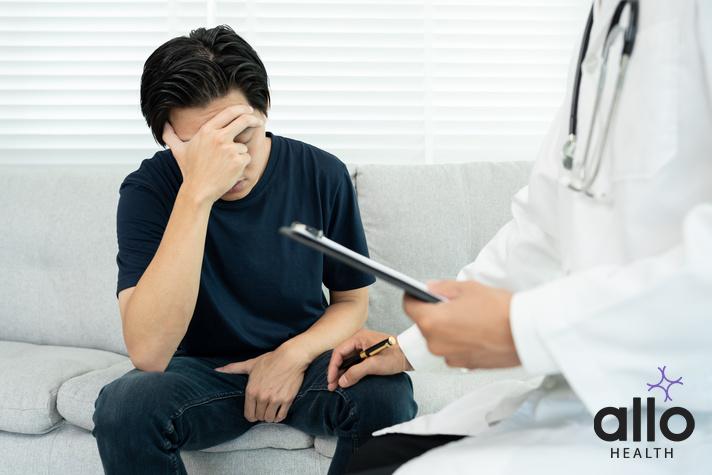What HPV Penile Melanosis?

Allo Health is dedicated to personalized well-being, offering support and trusted information tailored to individual health goals. The platform emphasizes human-generated content, led by a distinguished medical team of experts, including physicians and sexual health specialists. Their commitment to credibility involves rigorous fact-checking, authoritative research, and continuous updates to ensure accurate, up-to-date information. Allo Health's unique approach goes beyond conventional platforms, providing expert-led insights and a continuous commitment to excellence, with user feedback playing a crucial role in shaping the platform's authoritative voice.

Dr Sanina Mansoor holds MBBS degree from Yenepoya university,Mangalore.She has 8 years of experience working as a medical officer at various health centres and medical colleges.
Why This Was Upated?
Our experts continually monitor the health and wellness space, and we update our articles when new information became available.
Updated on 17 March, 2024
- Article was updated as part of our commitment to diversity, equity, and inclusion.

"The following blog article provides general information and insights on various topics. However, it is important to note that the information presented is not intended as professional advice in any specific field or area. The content of this blog is for general educational and informational purposes only.
Book consultation
The content should not be interpreted as endorsement, recommendation, or guarantee of any product, service, or information mentioned. Readers are solely responsible for the decisions and actions they take based on the information provided in this blog. It is essential to exercise individual judgment, critical thinking, and personal responsibility when applying or implementing any information or suggestions discussed in the blog."
HPV Penile Melanosis is a type of skin condition that affects the penis and can cause discomfort and anxiety to men who experience it. In this article, we will explore the causes, symptoms, and treatment options available for HPV Penile Melanosis, as well as natural remedies, prevention strategies, and possible complications associated with this condition.
What Is HPV Penile Melanosis?
- HPV (Human Papillomavirus): HPV is a group of viruses that can infect various parts of the body, including the genital area. Some types of HPV can lead to the development of genital warts, while others may increase the risk of certain cancers, such as cervical, penile, and anal cancers.
- Penile Melanosis: Penile melanosis refers to the presence of pigmented areas on the skin of the penis. This can manifest as dark or brownish spots or patches. While this condition is generally considered benign and is not associated with cancer, any changes in the pigmentation of the skin should be evaluated by a healthcare professional to rule out more serious conditions.
It’s essential to note that the term “HPV Penile Melanosis” might not be a widely recognized medical term. If you have concerns about changes in pigmentation on the penis or potential HPV infection, it is crucial to consult with a healthcare provider. They can perform a thorough examination, order any necessary tests, and provide appropriate guidance based on your specific situation.
Keep in mind that medical terminology and understanding can evolve, so it’s always advisable to seek the most up-to-date information from reliable healthcare sources.
HPV Penile Melanosis Symptoms
“HPV Penile Melanosis” is not a widely recognized medical term, and there may not be specific symptoms associated with it. But here are general symptoms of two related conditions: HPV infection and penile melanosis.
- HPV Infection Symptoms:
- Genital Warts: One of the most common symptoms of genital HPV infection is the development of warts on or around the genital and anal areas. These warts can be flat, raised, single, or in clusters.
- No Visible Symptoms: In many cases, HPV infections are asymptomatic, meaning there may be no visible signs or symptoms. Despite the lack of symptoms, an individual can still transmit the virus to others.
- Penile Melanosis Symptoms:
- Skin Discoloration: Penile melanosis manifests as pigmented areas on the skin of the penis. These areas may appear darker or brownish.
- Asymptomatic: In most cases, penile melanosis is asymptomatic and does not cause discomfort, pain, or itching. It is typically considered a benign condition.
HPV Penile Melanosis Causes
- HPV Infection Causes:
- Sexual Contact: HPV is primarily transmitted through direct skin-to-skin contact, often during sexual activity. It can be spread through vaginal, anal, or oral sex.
- Asymptomatic Carriers: Individuals infected with HPV may not exhibit any symptoms but can still transmit the virus to their sexual partners.
- Genital Warts: Certain types of HPV can cause the development of genital warts. These warts are caused by specific strains of the virus.
- Penile Melanosis Causes:
- Melanin Production: The pigmentation on the skin, including the penis, is due to the production of melanin. The presence of melanin can lead to variations in skin color.
- Age and Genetics: Some changes in skin pigmentation can be influenced by age and genetics. Penile melanosis is often considered a benign condition associated with natural variations in pigmentation.
HPV Penile Melanosis Treatment

- Treatment of HPV Infection:
- No Cure: There is no cure for HPV, but the majority of cases resolve on their own over time.
- Wart Removal: If genital warts are present and causing discomfort, they can be treated or removed. Treatment options may include topical medications, cryotherapy (freezing), laser therapy, or surgical removal.
- Monitoring and Vaccination: Regular monitoring and follow-up with a healthcare provider are essential. Vaccination against certain high-risk HPV strains (e.g., Gardasil 9) is available and is recommended for preventing HPV-related cancers.
- Management of Penile Melanosis:
- Observation: In many cases, penile melanosis is a benign and asymptomatic condition that does not require treatment. Healthcare providers may recommend observation without intervention.
- Biopsy: If there are concerns about the pigmented areas or if there are changes in appearance, a healthcare provider may perform a biopsy to rule out more serious conditions.
- Sun Protection: Protecting the skin from excessive sun exposure may help prevent changes in pigmentation.
It’s crucial to note that individual cases may vary, and the management approach will depend on the specific characteristics of the condition and the individual’s health. If you are experiencing changes in pigmentation on the penis or are concerned about potential HPV infection, it is essential to consult with a healthcare professional. They can provide a thorough examination, order any necessary tests, and offer guidance based on your specific situation.
HPV Penile Melanosis Prevention
- Prevention of HPV Infection:
- Vaccination: The most effective way to prevent certain HPV infections is through vaccination. HPV vaccines, such as Gardasil 9, are available and are recommended for both males and females. These vaccines protect against several high-risk HPV types that can lead to cancers, as well as low-risk types that cause genital warts.
- Safe Sexual Practices: Consistent and correct use of condoms can reduce the risk of HPV transmission, although they may not provide complete protection since the virus can infect areas not covered by a condom.
- Monogamous Relationships: Limiting the number of sexual partners and being in a mutually monogamous relationship can reduce the risk of HPV transmission.
- Regular Screenings: For individuals with a cervix, regular Pap smears and HPV testing as recommended by healthcare providers can help detect and manage HPV-related changes early.
- Prevention of Penile Melanosis:
- Sun Protection: Protecting the skin on the penis from excessive sun exposure may help prevent changes in pigmentation. This can include using sunscreen on the genital area if sun exposure is anticipated.
- Regular Self-Examinations: Being aware of one’s own body and regularly checking for any changes in pigmentation, texture, or other abnormalities on the penis can help detect potential concerns early.
- Medical Evaluation: If there are concerns about pigmented areas or other changes in the genital skin, seeking prompt medical evaluation is important. Healthcare professionals can provide guidance and perform necessary examinations or tests.
It’s essential to note that preventive measures can vary based on individual circumstances, and it is advisable to consult with a healthcare professional for personalized advice and guidance. Additionally, staying informed about the latest developments in sexual health and receiving regular check-ups are key components of preventive care. For the most up-to-date information, please consult with a healthcare provider or refer to authoritative medical sources.
Most Asked Questions
-
What is HPV Penile Melanosis?
Penile melanosis is not a well-recognized medical term. But, the combination of "HPV" (Human Papillomavirus) and "Penile Melanosis" suggests a potential relationship between HPV infection and pigmentation changes on the penis. HPV is a group of viruses associated with various skin conditions, including genital warts, while penile melanosis refers to pigmented areas on the penis.
-
Are there specific symptoms of HPV Penile Melanosis?
There isn't a defined set of symptoms for "HPV Penile Melanosis." But, individuals may notice pigmented areas on the penis, and any changes in pigmentation should prompt a consultation with a healthcare professional. HPV infections can manifest with genital warts, but many cases are asymptomatic.
-
What causes HPV Penile Melanosis?
The causes of "HPV Penile Melanosis" are not well-established. HPV infections are typically transmitted through sexual contact, and penile melanosis may be influenced by factors such as melanin production, age, and genetics. Any changes in pigmentation on the penis should be evaluated by a healthcare provider.
-
How is HPV Penile Melanosis treated?
There isn't specific information on the treatment of "HPV Penile Melanosis." But, managing potential HPV infection may involve addressing symptoms such as genital warts, while penile melanosis, often a benign condition, may not require treatment. Consultation with a healthcare professional is crucial for personalized guidance.
-
Can HPV Penile Melanosis be prevented?
Preventing "HPV Penile Melanosis" involves general measures for HPV infection and skin health. Vaccination against HPV, practicing safe sex, and regular screenings are essential for preventing HPV-related concerns. Protecting the skin from excessive sun exposure can contribute to overall genital health and may help prevent changes in pigmentation.






































